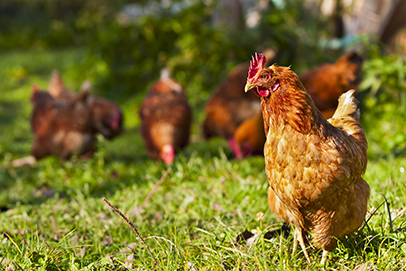Protecting your poultry from pests and disease
11 Mar 2022
PRODUCTION ADVICE / NRM NEWS - MARCH 2022 - ANIMAL HEALTH
By Mark Stillman
District Veterinarian
M: 0499 589 822 | E: mark.stillman@lls.nsw.gov.au

Whether you keep poultry as a commercial enterprise, or on a smaller scale to supply eggs for your kitchen, there are important signs to keep an eye out for to ensure your birds are happy and healthy.
As with other species, there are diseases in chickens that are notifiable in NSW, including Avian Influenza and Newcastle disease. Some poultry diseases can also cause illness in humans. This makes hygiene when handling chickens and eggs, such as hand washing after contact, vitally important. In the last 2 months, there have been a large number (>1000) of avian influenza cases reported in wild and domestic birds in Europe, Asia, Africa and the Americas. Wild birds are often the source of the introduction of the virus to poultry so limiting interactions between your birds and wild birds, who can harbour disease without being ill, is a way to safeguard against potential disease exposure.
Steps to reduce the risk of disease in birds include:
- Avoid using surface water, unless treated. Dam, river and channel water can easily be contaminated and a source of infection to birds.
- Feed should be appropriate for the age and type of bird, from a reputable source, and stored well to stop access and contamination from wild birds and rodents.
- Drinkers and feeders should be checked and cleaned regularly.
- Avoid movements of people or equipment between your birds and other flocks.
- Keep new birds separate from your existing flock for 30 days to watch for diseases before joining the flock. Sourcing vaccinated birds is best.
- Avoid contact between wild birds and your flock. Restrict access of your birds to areas where wild birds congregate (ie. Ponds/dams) and stop wild birds from accessing coops/housing and feed.
The symptoms of diseases can range from subtle to dramatic. If you suspect a disease within your flock call your veterinarian, your local land services district veterinarian or the emergency animal disease hotline on 1800 675 888.
Common symptoms to be on the lookout for include:
- A decrease in food and/or water consumption.
- Sudden changes in egg production, such as
- Unexpected drop in production.
- Changes to eggs – soft shells/crinkled shells/eggs with no shell.
- The sudden death of several birds.
- Changes in behaviour, including
- Inactivity.
- Hunched/fluffed up with ruffled feathers.
- Birds isolating and standing by themselves.
- Changes in appearance, such as
- Watery eyes or nose.
- Swelling around the eyes, comb, or wattles.
- Lesions on the comb or wattles.
- Changes in function, including
- Sneezing or coughing.
- Rasping when breathing.
- Diarrhoea or other changes in faeces.
For more information on keeping poultry and birds please see the backyard chickens fact sheet that links to more resources on poultry keeping, disease information, and food safety.